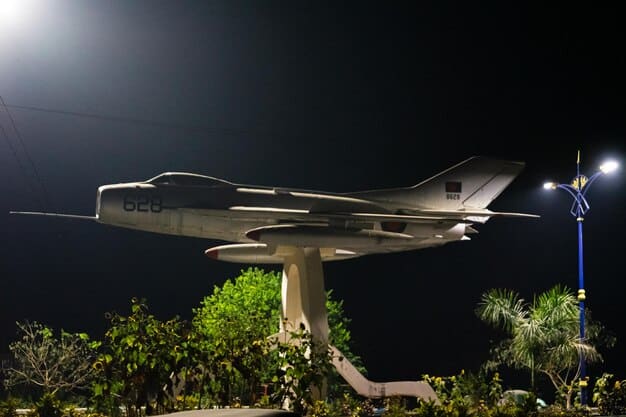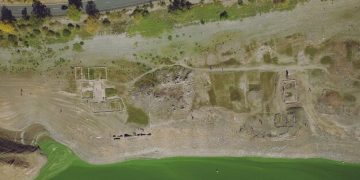US Military Counter-Drone Tech: Protecting Bases from Threats

The US military is rapidly developing a multi-layered approach to counter-drone technology, integrating kinetic and non-kinetic systems, advanced AI, and sophisticated detection methods to safeguard its domestic and international military bases from increasingly sophisticated aerial threats.
The proliferation of unmanned aerial systems (UAS), commonly known as drones, presents a significant and evolving threat to military installations worldwide. Understanding How is the US Military Developing Counter-Drone Technology to Protect Military Bases? is crucial, as these efforts represent a pivotal shift in modern defense strategies. From insurgent groups to state-sponsored actors, drones offer a low-cost, high-impact means of reconnaissance, surveillance, and even kinetic attack, demanding innovative and robust countermeasures to ensure the security of critical assets and personnel.
the escalating drone threat to military installations
The landscape of modern warfare has been irrevocably altered by the widespread availability and increasing sophistication of drones. Once primarily the domain of highly developed militaries, these unmanned aerial vehicles (UAVs) are now accessible to a broad spectrum of actors, from well-funded adversaries to non-state groups, democratizing aerial capabilities and presenting unprecedented challenges to traditional defense perimeters. The low cost, ease of operation, and versatility of drones make them an attractive tool for intelligence gathering, target acquisition, and even direct attack, compelling military forces globally, particularly the U.S., to rapidly adapt their defensive postures.
Militaries are increasingly confronted with a diverse array of drone threats. These can range from small, commercially available quadcopters modified for surveillance or carrying improvised explosive devices (IEDs), to larger, more advanced fixed-wing drones capable of extended flight and sophisticated reconnaissance. The sheer volume of drone incursions, often occurring simultaneously, can overwhelm conventional air defense systems designed for larger, faster targets. The ability of these smaller drones to operate at low altitudes, exploit urban clutter, and evade traditional radar signatures further complicates detection and interception, requiring a paradigm shift in defensive technologies and tactics.
types of drone threats encountered
The threat spectrum is broad, necessitating a multi-faceted defense.
- Commercial off-the-shelf (COTS) drones: Easily acquired, inexpensive, and readily modified for nefarious purposes, including carrying small payloads or conducting persistent surveillance. Their ubiquity makes them difficult to track and identify.
- Custom-built and weaponized drones: Advanced non-state actors or smaller nations can craft drones specifically for attack or reconnaissance. These may incorporate stealth features, longer range, or more destructive payloads.
- Swarm attacks: The coordinated deployment of multiple drones simultaneously, designed to overwhelm air defenses through sheer numbers, disrupting operations or creating exploitable vulnerabilities.
- GPS spoofing and jamming: Sophisticated adversaries can attempt to disrupt drone control signals or manipulate GPS data, potentially turning friendly drones into threats or causing system failures.
This evolving threat demands a defense strategy that is not static but continuously innovates. The U.S. military recognizes that a single “silver bullet” solution is insufficient; instead, it is pursuing a layered defense integrating multiple technologies and approaches to mitigate the risks posed by these increasingly prevalent aerial adversaries. This comprehensive strategy considers the diverse characteristics of potential drone threats, from their size and speed to their operational altitude and payload capabilities, ensuring a robust and adaptable defensive posture.
a layered approach: detection, identification, and defeat
Protecting military bases from the pervasive and evolving drone threat necessitates a highly sophisticated and multi-layered defense strategy. This approach begins long before a potential threat reaches the perimeter, emphasizing early detection, meticulous identification, and ultimately, effective defeat of the unmanned aerial system (UAS). The U.S. military’s commitment to this layered methodology reflects an understanding that no single technology or tactic can comprehensively address the diverse array of drone threats. Instead, a combination of kinetic and non-kinetic solutions, integrated seamlessly, offers the most robust protection.
Detection capabilities are the cornerstone of any counter-drone system, forming the initial layer of defense. These systems must be capable of identifying small, fast-moving objects across varied terrains and atmospheric conditions, distinguishing them from birds, false positives, or authorized air traffic. Once detected, rapid and accurate identification is paramount, determining whether the object is a recreational drone, a commercial delivery vehicle, or a hostile threat. This assessment informs the appropriate response, minimizing the risk of engaging friendly or benign platforms.
The defeat component encompasses a range of escalating options, from non-lethal disruption to kinetic neutralization. The choice of defeat mechanism depends on factors such as the type of drone, its payload, its proximity to critical assets, and civilian presence. This layered response ensures that military personnel have the flexibility to apply the minimum necessary force to neutralize a threat, mitigating collateral damage while effectively safeguarding installations.
advanced detection systems: the first line of defense
Effective detection is often the most challenging aspect due to the small size, low radar cross-section, and often slow speeds of many drones.
- Multi-spectral radar: Traditional radars struggle with small drones, but specialized multi-spectral radars, operating across different frequency bands, can detect these elusive targets more effectively, discriminating them from clutter.
- Acoustic sensors: Distributed acoustic sensor arrays can detect the unique sound signatures of drone propellers, especially at close ranges or in environments where line-of-sight is obstructed.
- Electro-optical/infrared (EO/IR) cameras: High-resolution EO/IR cameras provide visual identification and tracking capabilities, particularly useful in daylight and night conditions, and can confirm threats detected by other sensors.
- Radio frequency (RF) detection: Systems that scan for and identify specific RF signatures emitted by drones’ command and control links, providing early warning and classification.
Beyond primary detection, passive and active monitoring systems continuously analyze airspace, integrating data from various sensors into a unified common operating picture. This holistic view allows operators to track drone movements, predict trajectories, and assess potential threats in real-time. The ability to fuse data from disparate sources significantly enhances situational awareness, providing the crucial time needed to activate appropriate countermeasures.
non-kinetic countermeasures: disrupting the threat
Non-kinetic countermeasures represent a crucial and often preferred first line of defense against drones, particularly in scenarios where collateral damage must be minimized or when a kinetic solution is not immediately necessary. These technologies aim to disable, disrupt, or divert a drone without destroying it, often by interfering with its control, navigation, or communication systems. The U.S. military is heavily investing in these methods due to their flexibility, scalability, and reduced risk profile, particularly around populated areas or sensitive installations.
The primary objective of non-kinetic systems is to sever the link between the drone and its operator or to confuse its onboard systems. This approach can force a drone to land, return to its origin point, or simply drift harmlessly out of controlled airspace. Such methods are particularly effective against commercial and modified commercial drones, which often rely on standard communication protocols and GPS navigation. However, as adversaries develop more sophisticated drones with hardened systems or autonomous capabilities, the efficacy of purely non-kinetic solutions may be challenged, necessitating a continuous evolution of these technologies.
jamming and spoofing: electronic warfare at play
Electronic warfare (EW) is at the forefront of non-kinetic counter-drone operations.
- GPS jamming: Directed radio frequency (RF) energy can overwhelm the drone’s GPS receiver, denying it access to satellite navigation signals. This often causes the drone to initiate an emergency landing or return-to-home protocol, or simply renders it unable to navigate accurately.
- Command and control (C2) jamming: Interfering with the radio signals used by the drone operator to control the UAV. By flooding common frequency bands with noise, these jammers can break the communication link, causing the drone to go rogue or land.
- GPS spoofing: Generating false GPS signals that trick the drone into believing it is at a different location. This can effectively hijack the drone’s navigation, guiding it away from its intended target or forcing it to land in a controlled area.
These EW approaches are highly adaptable, capable of targeting specific frequency bands and power levels, allowing for precise engagement without disrupting other legitimate communications. The continuous development in this field focuses on more directional jamming, multi-band capabilities, and cognitive EW systems that can learn and adapt to new drone communication protocols and frequencies. The aim is to create intelligent electronic defenses that can dynamically respond to evolving drone threats, maintaining an advantage in the electromagnetic spectrum.
kinetic countermeasures: neutralizing airborne threats
While non-kinetic measures offer a valuable initial response, there are scenarios where a more definitive, destructive solution is required to neutralize an immediate and tangible threat. Kinetic countermeasures involve physically incapacitating or destroying the drone. These solutions are typically reserved for confirmed hostile drones that pose an imminent danger to personnel, critical infrastructure, or operational security, especially after non-kinetic methods have proven insufficient or inappropriate. The U.S. military is developing and deploying a range of kinetic options, balancing precision with rapid response capabilities.
The advancement in kinetic counter-drone technology reflects a shift from traditional anti-aircraft systems, which are often too slow, expensive, or imprecise for small, agile drones. Modern kinetic solutions are designed specifically to address the unique characteristics of UAVs, focusing on cost-effectiveness, minimal collateral damage, and the ability to engage multiple targets quickly. This includes both projectile-based systems and directed energy weapons, each offering distinct advantages depending on the operational context and threat assessment.
projectile-based systems and directed energy weapons
The spectrum of kinetic counter-drone technologies is expanding.
- Interception nets and projectiles: Net-firing drones or ground-based systems can physically capture or entangle smaller drones, bringing them down safely. Specialized projectiles, often utilizing shotgun shells or programmable airburst munitions, are designed to create a larger probability of hit against small, erratic targets.
- High-energy lasers (HEL): Directed energy weapons, such as HELs, offer a precise, scalable, and potentially low-cost-per-shot solution. They can burn through the drone’s airframe, optics, or internal electronics, causing it to crash. The speed of light engagement makes them highly effective against fast-moving targets.
- High-power microwaves (HPM): HPM systems emit bursts of microwave energy that can “fry” the internal electronics of a drone, regardless of its specific flight path, causing an immediate malfunction. These systems can potentially defeat multiple drones simultaneously.
Kinetic solutions are meticulously integrated into the layered defense strategy. Decision-making algorithms, often assisted by artificial intelligence, guide operators on when and how to deploy these measures, considering factors like flight path, payload, and potential trajectory upon impact. The ultimate goal is to provide a comprehensive defensive umbrella, where diverse kinetic tools are available to thwart any drone threat that penetrates the outer layers of non-kinetic defense.

integrating ai and machine learning into counter-drone systems
The sheer volume and dynamic nature of drone threats necessitate more than just independent defensive systems; they demand intelligent, adaptive, and predictive capabilities. This is where artificial intelligence (AI) and machine learning (ML) play a transformative role in the U.S. military’s counter-drone efforts. AI and ML are no longer just enhancements; they are becoming fundamental components, enabling faster threat assessment, more accurate identification, and optimized response strategies that far surpass human capabilities in speed and precision.
By integrating AI and ML, counter-drone systems gain the ability to analyze vast amounts of sensor data in real-time, sifting through noise to pinpoint potential threats with unprecedented accuracy. These intelligent algorithms can learn from past encounters, recognize novel drone signatures, predict flight paths, and even anticipate adversary tactics. This shifts the defense paradigm from reactive to proactive, allowing for quicker deployment of countermeasures and more efficient resource allocation, thereby significantly enhancing the overall defensive posture of military bases.
ai-powered threat assessment and autonomous response
AI offers critical advantages in processing complex scenarios.
- Enhanced detection and classification: ML algorithms are trained on immense datasets of drone imagery, radar signatures, and acoustic profiles to rapidly distinguish between benign air traffic, wildlife, and hostile drones. This reduces false positives and improves response times.
- Predictive analysis: AI can analyze drone flight patterns, speeds, and historical data to predict potential targets or intentions, allowing security forces to preemptively position defenses or prepare for specific threat trajectories.
- Swarm defense coordination: For complex swarm attacks, AI can instantly calculate optimal engagement strategies, coordinating multiple kinetic and non-kinetic systems to neutralize numerous threats simultaneously, a task impossible for human operators alone.
- Adaptive jamming and spoofing: ML-driven electronic warfare systems can rapidly identify and learn new drone communication frequencies and protocols, then adapt their jamming and spoofing techniques in real-time, maintaining effectiveness against evolving threats.
The application of AI extends beyond simple detection to intelligent decision support and, in some cases, autonomous response. While human-in-the-loop remains standard for kinetic engagements, AI can present optimal solutions to operators, recommend the most effective countermeasure based on current conditions, and even initiate non-lethal responses autonomously. This augmentation of human capabilities ensures that even under high-stress, rapidly evolving threat scenarios, military bases maintain a formidable and responsive defense against drone incursions.
challenges and future outlook in counter-drone technology
Despite significant advancements, the development and deployment of effective counter-drone technology are not without substantial challenges. The rapid pace of drone innovation, coupled with the increasing sophistication of adversarial tactics, creates a perpetual arms race. As militaries develop new countermeasures, adversaries invariably find new ways to circumvent them, necessitating continuous research, development, and adaptation. This dynamic environment means that any counter-drone solution, however advanced, carries a built-in obsolescence factor, demanding ongoing investment and strategic foresight.
Furthermore, integrating diverse counter-drone systems into a cohesive, interoperable defense network presents considerable technical and logistical hurdles. Issues such as sensor fusion, data sharing across different platforms, and the development of unified command and control systems are complex. The legal and ethical implications of autonomous engagement, particularly with kinetic systems, also demand careful consideration and policy development. Addressing these multifaceted challenges is crucial for the U.S. military to maintain a decisive edge in protecting its bases from future drone threats.
hardening defenses against adaptive adversaries
The future of counter-drone technology lies in anticipating and neutralizing tomorrow’s threats today.
- Multi-domain integration: Moving towards fully integrated air, ground, and cyber defense systems that share data seamlessly, providing a truly holistic picture of threats and enabling coordinated responses across all operational domains.
- Enhanced autonomy and AI robustness: Developing AI systems that are not only intelligent but also resilient to spoofing, jamming, and novel attack vectors. This includes self-healing algorithms and more sophisticated predictive models.
- Directed energy system maturation: Further refining high-energy lasers and high-power microwave systems to be smaller, more powerful, more energy-efficient, and capable of operating in diverse environmental conditions, making them more widely deployable.
- Counter-swarm capabilities: Dedicated research into technologies specifically designed to detect, track, and simultaneously neutralize large numbers of drones, including advanced interceptor drones or swarm-on-swarm tactics.
The imperative to protect military bases drives considerable investment in this field, pushing the boundaries of technological innovation. The U.S. military’s strategy is not merely to react to current threats but to proactively develop capabilities that deter future adversaries. This includes fostering partnerships with industry, academia, and international allies to share knowledge, accelerate development, and standardize best practices. Only through such comprehensive, forward-looking approaches can military installations remain secure in an increasingly complex and drone-permeated operational environment.

international cooperation and evolving doctrines
The challenge posed by drone proliferation extends far beyond national borders, affecting military installations and civilian infrastructure globally. Recognizing this pervasive threat, the U.S. military is not operating in isolation in its counter-drone development; rather, it actively engages in international cooperation, sharing intelligence, best practices, and even technology with allies. This collaborative approach is vital because drones and their associated technologies can quickly cross boundaries, making a unified, international response more effective than fragmented national efforts.
International cooperation also plays a critical role in standardizing protocols and fostering collective defense capabilities. By working with partner nations, the U.S. can help develop common operating procedures for identifying and responding to drone incursions, improving interoperability between allied forces. This collaborative environment also facilitates joint research and development, pooling resources and expertise to accelerate the creation of advanced counter-drone solutions and ensuring that the global defense community remains ahead of evolving threats.
joint exercises and information sharing agreements
Collaboration strengthens collective defense.
- NATO and allied partnerships: Engaging in joint military exercises focused on counter-UAS scenarios, allowing forces to test interoperability, refine tactics, and identify gaps in current capabilities.
- Intelligence sharing: Establishing robust mechanisms for sharing intelligence on new drone capabilities, emerging threat vectors, and adversary tactics with key allies, ensuring a common understanding of the evolving landscape.
- Technology exchange programs: Collaborating on specific research and development projects, and sometimes sharing developed technologies, to accelerate deployment of advanced counter-drone systems across allied forces.
- Standardization efforts: Working towards common technical standards for counter-drone systems, enabling seamless integration of different national systems in coalition operations.
Beyond technological development, international cooperation extends to the legal and ethical frameworks surrounding counter-drone operations. Discussions among allied nations are crucial for establishing acceptable rules of engagement, minimizing unintended consequences, and ensuring compliance with international law. This holistic approach, combining technological superiority with strategic partnerships and shared doctrinal understanding, provides a more robust and comprehensive defense against the global drone threat, protecting military bases and critical assets worldwide.
| Key Aspect | Brief Description |
|---|---|
| 🛡️ Layered Defense | Integrates detection, identification, and defeat systems for comprehensive base protection. |
| ⚡ Non-Kinetic Means | Utilizes jamming and spoofing to disrupt drone operation without destruction, minimizing collateral. |
| 💥 Kinetic Solutions | Includes lasers, microwaves, and projectiles for physical neutralization of confirmed threats. |
| 🧠 AI Integration | AI and ML enhance threat assessment, classification, and autonomous response capabilities. |
Frequently Asked Questions About Counter-Drone Technology
Military bases face threats ranging from small commercial off-the-shelf (COTS) drones modified for surveillance or carrying improvised explosive devices (IEDs), to larger custom-built reconnaissance and attack drones. Swarm attacks, involving multiple coordinated drones, and attempts at GPS spoofing or jamming also present significant challenges.
Non-kinetic systems primarily disrupt drones without destroying them. This is achieved through electronic warfare techniques like GPS jamming, which prevents navigation, or command and control (C2) jamming, which severs communication links. GPS spoofing can also mislead a drone into believing it’s in a different location, diverting it.
AI and machine learning are vital for rapid threat assessment, accurate identification, and optimized response. AI enhances detection by classifying targets, predicts flight paths, coordinates swarm defense, and enables adaptive jamming by learning new drone frequencies, significantly improving overall defense capabilities.
Yes, significant ethical considerations exist, particularly regarding autonomous engagement and minimizing collateral damage. The U.S. military is working with allies to establish clear rules of engagement and ensure compliance with international law, defining when and how kinetic or advanced non-kinetic measures can be employed responsibly.
Future trends include greater integration of multi-domain defense systems, enhanced AI resilience, maturation of directed energy weapons like high-energy lasers and high-power microwaves, and advanced counter-swarm capabilities. The focus is on proactive, intelligent, and scalable solutions that can adapt to rapid advancements in drone technology.
Conclusion: Securing the Skies for Military Operations
The relentless evolution of drone technology demands an equally dynamic and sophisticated response from the U.S. military to safeguard its bases. Through a comprehensive, layered approach encompassing advanced detection, potent non-kinetic disruptions, and precise kinetic defeat mechanisms, coupled with groundbreaking AI integration, the defense strategy is constantly adapting. This commitment to continuous innovation and international cooperation underscores a singular objective: to ensure the unparalleled security of military installations against present and future aerial threats, preserving operational integrity and protecting personnel worldwide.





